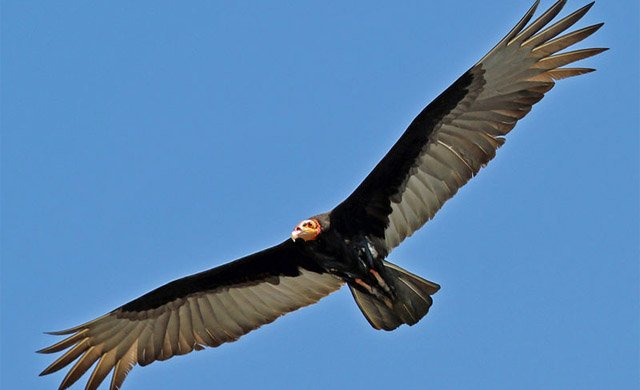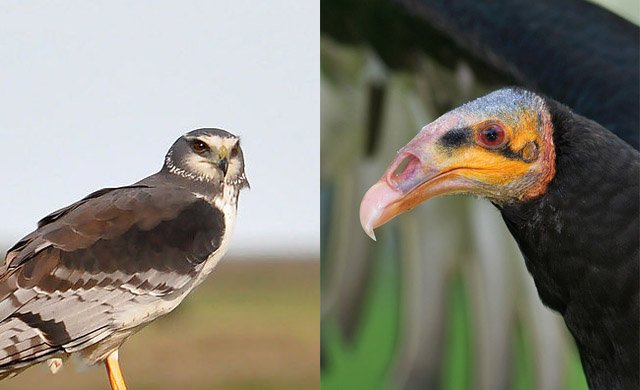
New World vultures of the genus Cathartes (Greater Yellow-headed, Lesser Yellow-headed and Turkey Vultures) look much alike. Greater and Lesser Yellow-headed Vultures are so similar that for a long time were thought to be the same species. The fact that one, the Lesser Yellow-headed Vulture, acted so differently and favored a different habitat alerted ornithologists to look closer and determine that indeed they were two separate species
Seeing a Lesser Yellow-headed Vulture (LYHV) forage on the grassy open floodplains of Amazonian Rivers is like seeing a Harrier in action. LYHV forage for food by flying right above open grasslands, turning around to double check a particular spot, and dropping suddenly apparently to catch a prey, just like Harriers do. Both Harrier and vultures hold their wings in a dihedral position and rock their body left and right as they fly. While LYHV and Harrier exhibit a similar foraging behavior they have different morphological adaptations.
Harriers listen for their prey aided by facial disks. They also have relatively large eyes that help the birds with an excellent sight. The Lesser Yellow-headed Vulture has a bald head and small eyes. They don’t have a visible morphological trait that helps them hear or see their prey as they inspect the terrain for prey. Additionally, Cathartes vultures are unable to grab, kill, and carry a prey item with their feed. Their feed are more like that of a Wood Stork.

Long-winged Harrier (left), photo: Claudio Dias Timm, and Lesser Yellow-headed Vulture (right). Photo: Arjan Haverkamp.
Like other vultures, Lesser Yellow-headed vultures are known to eat carrion, but only when this becomes available. They hardly ever fly high or venture away from the grassland and open habitats they favor, and appear to be territorial. All of these characteristics are very different from carrion feeding Cathartes Vultures, which fly high over extensive areas. The other Cathartes vultures have an incredible sense of smell and are able to find a small dead fish in the thick and seemingly uniform Tropical Rainforest floor.
Observing how Lesser Yellow-headed Vultures forage without the morphological traits of a Harrier suggests that these vultures maybe smelling their prey. This is not unusual, after all other Cathartes vultures use their sense of smell to find the carrion they feed on. What is unusual here is that these vultures may be sniffing for large invertebrates as their feet are no help when it comes to grab and kill a small mammal. This is pure speculation. It is just a field observation of a behavioral trait.
European Kestrels are known to see the urine trails their prey leave. Mice and vole urine is visible through ultraviolet vision that Kestrels appear to have… to some extend. I would certainly be nice to set up an experiment to learn what the Lesser Yellow-headed Vultures use to find their prey in the thick grasslands they favor.











Great post! Yes, that would be a good experiment. It seems like the Lesser Yellow-headed Vulture has become adapted to a harrier-like niche in some places where harriers are either absent or very rare.
That’s a pretty cool thought. Would be interesting to follow up.
Indeed Duncan. There may be something neat in a vulture behaving like that.
Yes Pat! Thanks for stopping by!